|
JNP Introduction: John Newton's Unedited Sermon Series on Messiah
John Newton's opinon of Handel's Messiah:
|
|
|
 |
|
|
"one of the highest and noblest gratifications this life is capable of"
|
|
proviso:
|
|
|
 |
|
|
IF...
"if any person present of a sound spiritual judgement, could have hoped that
the greatest part of the performers and audience were capable of entering into the spirit of the subject" |
How Newton's Messiah sermon series arose
|
"I have often wished... to be able to adopt some plan which might lead me in a regular succession of subjects, to exhibit the principal outlines of the Saviour’s character and mediation ... to comprise... a summary or system of evangelical divinity.
"Such a plan has lately occurred to me, and in an unexpected manner." |
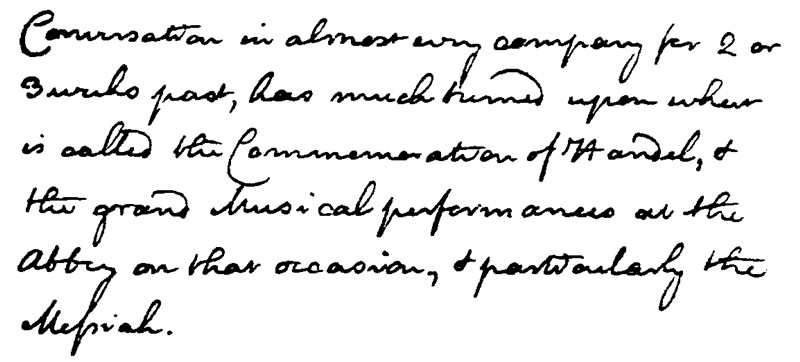 |
"Conversation in almost every company for two or three weeks past,
has much turned upon what is called:
'the Commemoration of Handel',
and the grand musical performances at the Abbey on that occasion,
and particularly the Messiah."
|
|
Newton then went through every Scripture text forming the libretto of Handel's Messiah, preaching a series of 50 sermons in all from the Oratorio. He published them in two volumes. One of his preparatory notebooks exists, which is transcribed within this website (accessed from the navigation panel on the left of this page). |
'The Commemoration of Handel'
|
|
In 1783 it was proposed that ‘A performance might be exhibited on so grand and magnificent a scale as no other part of the world could equal’. [1] |
As it happened, the following year, 1784, would herald special anniversaries of both the birth and death of George Handel, making his works an obvious choice, and Westminster Abbey ‘where the bones of the great Musician were deposited’, the ‘properest place for the performance’.
The King consented to give his patronage, the Directors of the Concert of Antient Music volunteered to manage and direct the event, and an ‘admirable architect’ was appointed to provide ‘the elegant designs for the Orchestra and Galleries – which when filled constituted one of the grandest and most magnificent spectacles which imagination can delineate’.
‘A more numerous band than was ever known to be collected in any country, or on any occasion whatever’ was assembled – around 600 choir and orchestra. An organ destined for Canterbury Cathedral was diverted to the Abbey, carefully placed ‘in a Gothic frame, mounting to, and mingling with the saints and martyrs represented in the painted glass on the West window’. |
Vast constructions were erected in the Abbey
|
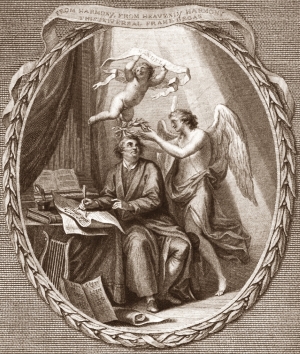 |
Handel being honoured by heavenly beings
the banner above reads:
'From harmony,
from heavenly harmony, this universal frame began' |
Charles Burney:
"A Public and national tribute of gratitude to deceased mortals, whose labours and talents have benefitted, or innocently amused, mankind, has, at all times, been one of the earliest marks of civilization in every country emerged from ignorance and barbarism.
And there seems no more rational solution of the mysteries of ancient Greek mythology, than to imagine that men, whose virtue and abilities surpassed the common standard of human excellence, had excited that degree of veneration in posterior times, which gave rise to their deification and apotheosis." |
|
The event was attended by ‘their majesties and the first personages of the kingdom, the Bishops, the Dean and Chapter of Westminster, the families and friends of the Directors, the prebendaries of Westminster, their Majesty's suite, maids of honour, grooms of the bed-chamber, pages, &c.’ together with ‘the Directors themselves, who were all distinguished by white wands tipped with gold, and gold medals, struck on the occasion, appending from white ribbands’.
The magnitude of the band (i.e. orchestra and choir) ‘commanded and impelled adhesion and obedience, beyond that of any other of inferior force. The pulsations in every limb, and ramifications of veins and arteries in an animal, could not be more reciprocal, isochronous, and under the regulation of the heart, than the members of this body of Musicians under that of the conductor and leader’.
The powers of the ‘totality of sound’ produced ‘new and exquisite sensations in judges and lovers of the art’ and were ‘felt by those who never received pleasure from Music before’. |
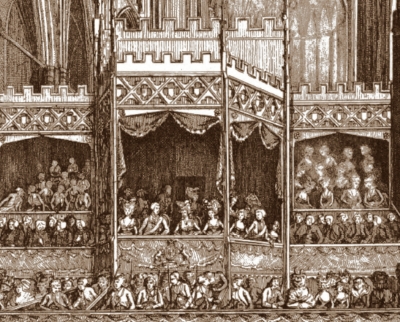
The sketch of the gallery, is by Edward Franscisco Burney
(nephew of Charles Burney), engraved by Jonathan Spilsbury
(whose daughter Rebecca Maria Ann married John Taylor,
son of Newton's close friend Walter Taylor of Southampton). |
|
As Burney remarked to the King: 'a quick sensibility of Melody and Harmony, is not always originally bestowed, and those who are born with this susceptibility of modulated sounds, are often ignorant of its principles, and must therefore be in a great degree delighted by chance…' |
Newton's ms sermon notes for Messiah
|
|
Newton described the contents of his Messiah sermon notebook as 'short stamina notes [2] which I put down as I go on." [3] |
|
We are only aware of one remaining personal notebook of Newton’s containing his unedited notes, made in preparation for preaching his series on the texts from Handel’s Messiah. It is owned by the Cowper & Newton Museum. It contains an Introductions and 12 sermons. These transcripts are made from that notebook. |
|
There may, perhaps, be further notebooks somewhere in the world. If so, we would love to see them. His personal notes are generally richer, with great warmth, especially in this series, which he subsequently edited and published with the non-church-goer in mind (impressively bound in fine leather with gilt pages to add to their attraction!). |
In our transcripts of the manuscripts, in order to distinguish between the two different ‘Messiah’s being mentioned (the title of Handel's oratorio and the Lord Jesus Christ), we have imitated Newton’s format in his printed volumes, using:
‘the Messiah’ ( italics) for Handel’s oratorio, and ‘Messiah’ (small caps) for the person, Christ. |
|
In these mss Newton refers to ‘the Messiah’ but in the printed version he made a further distinction, omitting the definite article, and just writing ‘Messiah’, as one would normally use for a person’s name. |
|
In his notebook, apart from his sermon No. 1, Newton omitted writing out the texts in his chapter headings. We have shown, in square brackets, the portion of texts he preached on as they appear in his printed version. |
|
The notebook includes these sermons: |
|
Introduction |
[in the printed version this was absorbed into No. 1] |
|
No. 1 |
Isaiah 40:1,2 |
|
No. 2 |
Isaiah 40:3-5 |
|
No. 3 |
Haggai 2:6,7 |
|
No. 4 |
Malachi 3:1-3 |
|
No. 5 |
Isaiah 7:14 |
|
No. 6 |
Isaiah 40:9 |
|
No. 7 |
Isaiah 60:1-3 |
|
No. 8 |
Isaiah 9:2 |
|
N0. 9 |
Isaiah 9:6 |
|
No. 10 |
Luke 2:8-14 |
|
No. 11 |
Zechariah 9:9,10 |
|
No. 12 |
Isaiah 35:5,6 |
|
Newton's printed Messiah sermons
|
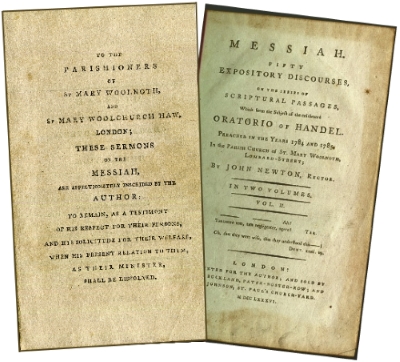
dedication and title page |
MESSIAH
Fifty Expository Discourses
on the series of
Scripture Passages
which form the subject of the celebrated
ORATORIO of HANDEL
Preached in the years 1784 and 1785
in the parish church of St Mary Woolnoth,
Lombard Street
by JOHN NEWTON, Rector |
To the Parishioners of
St Mary Woolnoth and St Mary Woolchurch Haw, London
These Sermons
on
THE MESSIAH
are affectionately inscribed by
The Author;
to remain as a testimony of his respect for their persons,
and his solicitude for their welfare,
when his present relation to them,
AS THEIR MINISTER,
shall be dissolved. |
_ Ah!
Tantamne rem tam negligenter agere! Terence
[that he should have so little care in a business of so great import!]
Unum pro multis dabitur caput. Virgil
[one head shall be given for many]
For the love of Christ constraineth us; because we thus judge, that if one died for all, then were all dead; abnd that he died for all. that they which live should not henceforth live unto themselves, but unto him which died for them, and rose again.
2 Corinthians 5:14,15
Oh, that they were wise, that they understood this!
Deuteronomy 32:29
|
|
|
|
Newton began transcribing from his notebooks in January 1785, overlapping his preaching of the series. He finished preaching around the end of June 1785. The main section of the book was printed during March 1786, but publication was delayed, for: “we must wait awhile for an index, without which I do not think a book complete.”
His transcribing and editing for the press had taken him less than ten months, amidst many engagements and family trials. As publication drew near, he appealed to Bull: “I intreat your prayers that the Lord may be pleased to breathe his blessing upon a service, which I trust he himself put into my heart… If the Lord is pleased to make it useful, it would be foolishness in me to be much concerned what my fellow-worms may think of the performance… I certainly could not take leave of the press with a more noble subject.”
As he explained in his Preface, regarding the sermons, "most of them are considerably abridged", for they were originally aimed at a wide-ranging audience. As every congregation includes some people there for the first time, when he preached in church "repetitions could not be always avoided". For similar reasons, he did not eliminate repititions in the published sermons: "Many persons read part of a book, who may not have opportunity or inclination to read the whole. Should any one, by opening these Sermons at a venture, meet with a passage which, by a divine blessing, may either awaken a careless, or heal a wounded spirit, that passage will be exactly in the right page, even though the purport of it should be expressed in several other places."
He used the illustration of of a hammer to show that although the final stroke might seem to be the one which drives in a nail, none of the preceding strokes would have been superfluous. Likewise, "since we do not always so much stand in need of new information, as to have what we already know more eflectually impressed upon the mind; there are truths which can scarcely be inculcated too often."
He asked his readers to bear with him if he "ventures, in some instances, to deviate a little more from the beaten track." Experience had made him less sceptical in some areas, and less dogmatic in others. A minister, he said, should preach "Christ Jesus the Lord, and him crucified. He dares not sophisticate, disguise, or soften the great doctrines of the grace of God, to render them more palatable to the depraved taste of the times." |
|
He closed by proclaiming that: |
|
"Messiah, the great subject of the Oratorio, is the leading and principal subject of every sermon." |
|
"His person, grace, and glory ; his matchless love to sinners ; his humiliation, sufferings and death ; his ability and willingness to save to the uttermost ; his kingdom, and the present and future happiness of his willing people, are severally considered, according to the order suggested by the series of texts." |
|
For a table of Newton's sermon texts linked to Handel's libretto (by Charles Jennens) see here |
|
The printed sermons may be found in Newton's Works. A 4-volume reformatted modern-type edition of Newton's Works, including Messiah, was recently published by Banner of Truth. |
|
A digital edition of Newton's Messiah sermons, lightly edited by Dr Susan Maartens, is available at CCEL to read online or download. |
|
A copy of Newton's 1786 edition of Messiah inscribed for his future 'niece'. |
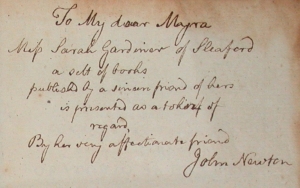 |
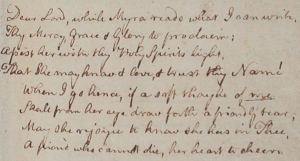 |
|
Inscription:
To My dear Myra
Miss Sarah Gardiner of Sleaford
a set of books published by a sincere friend of hers is presented as a token of regard
By her very affectionate friend
John Newton
No. 6 Coleman Street Buildings
27 January 1794
|
|
The above front page of Newton's Messiah [4] is inscribed for Sarah Myra Gardiner, who later married Newton's nephew Benjamin Nind (son of Newton's half-sister Thomasina).
Dear Lord, while Myra reads what I can write,
Thy Mercy, Grace & Glory to proclaim ,
Assist her with Thy Holy Spirt's light,
That she may know & love, & trust Thy Name.
When I go hence, if a last thought of me
Shall from her eye draw forth a friendly tear,
May she rejoice to know she has in Thee
A friend who cannot die, her heart to cheer. |
Endnotes:
|
[1] |
Charles Burney, An Account of the Musical Performances in Westminster Abbey and the Pantheon, May 26th, 27th, 29th; and June the 3rd, and the 5th, 1784, in Commemoration of Handel, London, 1785. An online copy is here. |
|
[2] |
‘stamina notes’: outlining the ‘basic elements’ of his sermons |
|
[3] |
Newton to William Bull, 6 December 1784, One Hundred and Twenty-Nine Letters. |
|
[4] |
Newton's 2 volumes of Messiah, published in 1786, inscribed to Sarah Myra Gardiner, are in private ownership. Our thanks to the owners for permission to fetaure them here. |
Acknowledgements:
Cowper & Newton Museum, Olney
|
Marylynn Rouse, 01/12/2015
|
|
|